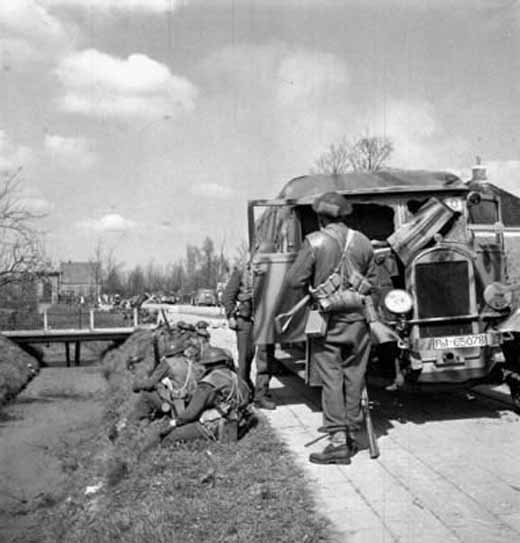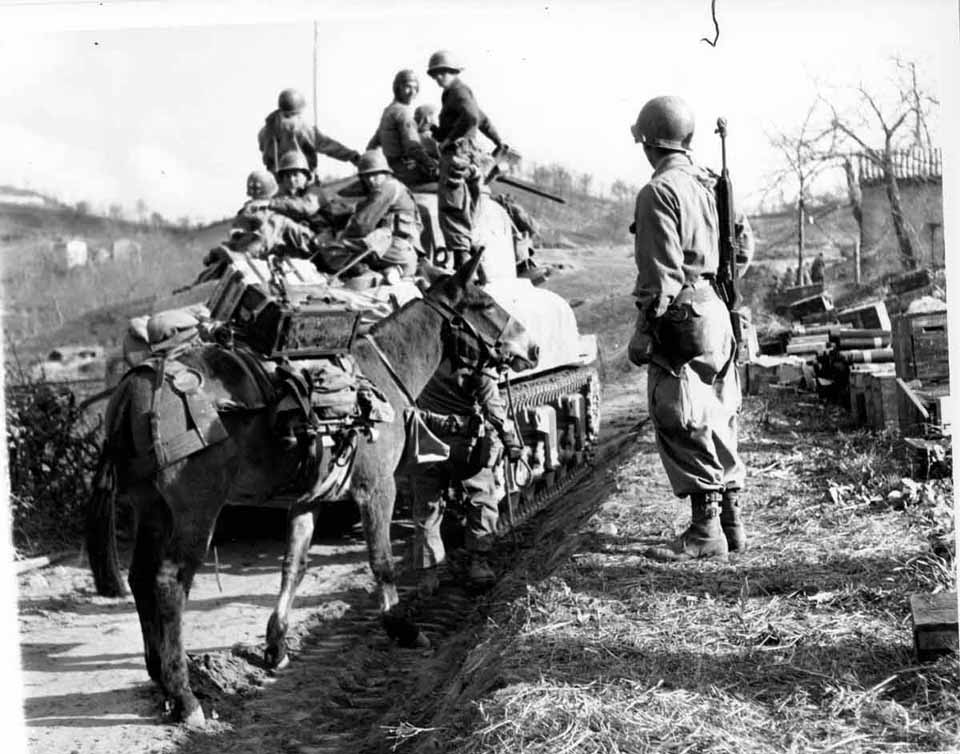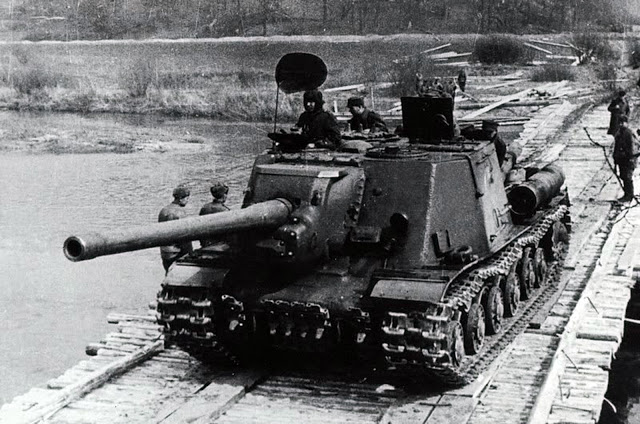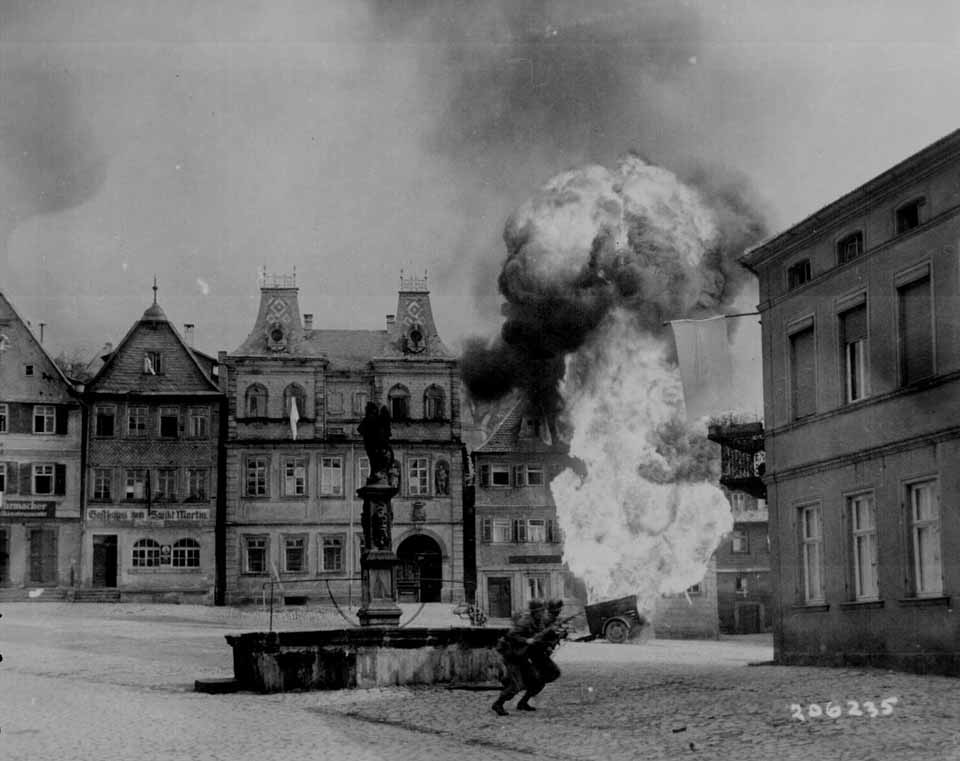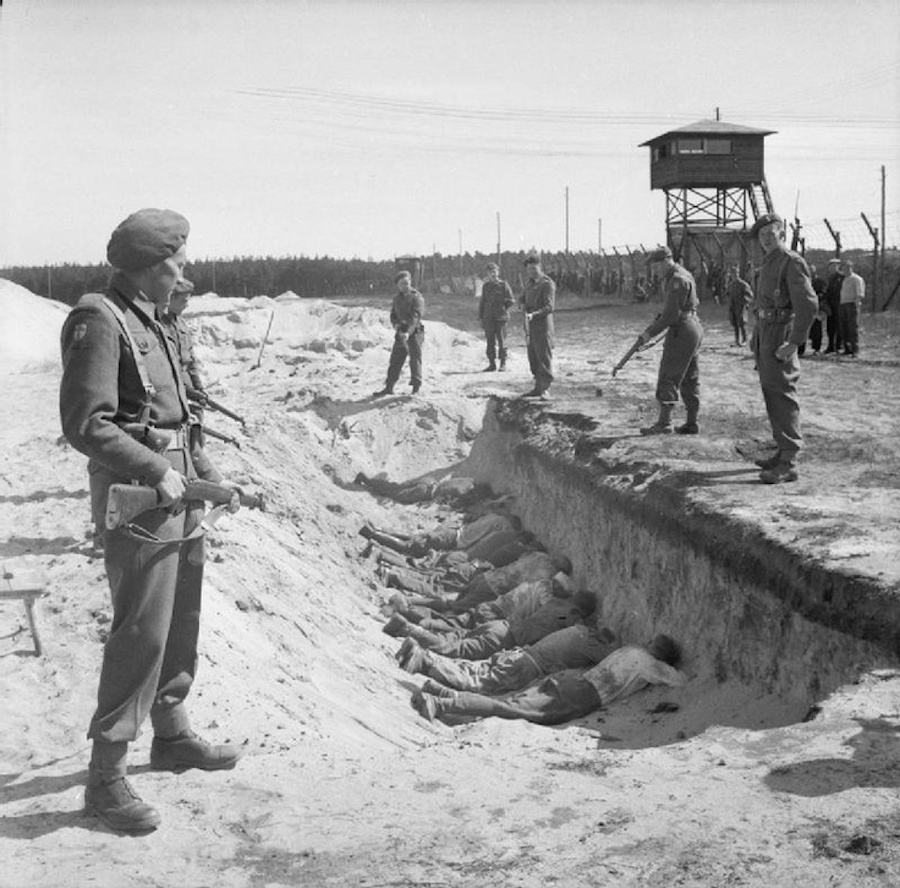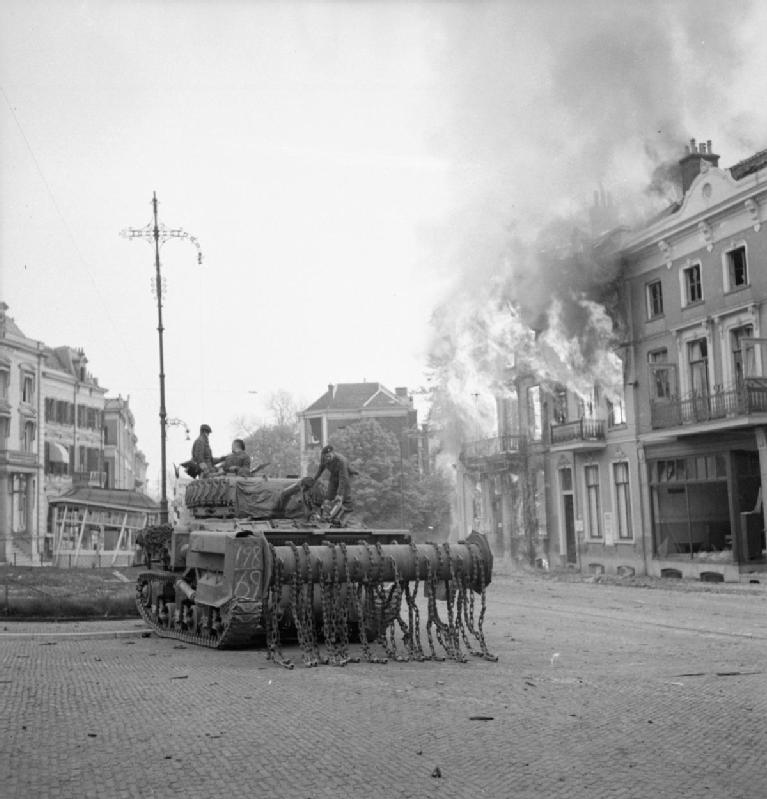Air Operations, CBI
BURMA- 41 10th Air Force P-47s and 459th Fighter Squadron P-38s attack troops, fuel dumps, and supplies at 4 locations in central Burma.
- 8 P-38s attack bridges at 2 locations.
- 24 308th Heavy Bomb Group B-24s and 12 14th Air Force P-51s attack Loyang and a bridge spanning the Yellow River.
- 30 341st Medium Bomb Group B-25s and more than 130 14th Air Force fighter-bombers attack troops, bridges, transporation targets, stores, and other targets across southern and eastern China.
- V Bomber Command B-25s attack ships and other targets while sweeping waterways in the Canton and Hong Kong areas.
- Responding to the dire threat to Japan posed by the successful Allied landings in the Ryukyu Islands, 4 Japanese Army infantry divisions in eastern China are shifted to northern and central China in such a way as to allow for their eventual return to Japan. In the first move, the rail line linking several former 14th Air Force bases is abandoned, which will in time lead to the loss or abandonment of those bases by the Japanese.
Air Operations, Europe
RAF BOMBER COMMANDDaylight Ops:
- 20 Lancasters of No. 617 Squadron again find their target at Swinemünde covered by cloud and return without bombing.
- There are no losses.
- 500 Lancasters and 12 Mosquitos of Nos. 1, 3 and 8 Groups attackePotsdam. This is the first time that Bomber Command 4-engined aircraft have entered the Berlin defense zone since March 1944, but the approach, across parts of Germany recently captured by Allied troops, and the Cuxhaven diversion leads to only 1 Lancaster being lost. It is shot down by a night fighter.
- This is the last raid of the war by a major Bomber Command force on a German city. The aiming point is the center of Potsdam and the intention is to destroy the local barracks, a depot of the old German Guards regiments, and the railway facilities. The attack is reasonably successful and severe damage is caused in Potsdam, but bombs also fall in the nearby northern and eastern districts of Berlin.
- 24 Lancasters and 4 Mosquitos make a diversionary raid to Cuxhaven, 62 Mosquitos are sent to Berlin and 10 to Wismar, and there are 50 Mosquito patrols and 54 RCM sorties.
- There are no losses.
FRANCE:
- Preceding a clearing operation to be launched by French Army ground forces, 1,133 8th Air Force heavy bombers attack fortifications, strongpoints, gun emplacements, and flak positions at Bordeaux and other German defensive positions remaining along the French Atlantic coast.
- 4 heavy bombers are lost.
GERMANY:
- 9th and 1st Tactical Air Force fighter pllots down 14 Luftwaffe aircraft between 1330 and 1840 hours.
ITALY:
- Although diverted by bad weather from primary targets in Brenner Pass, 12th Air Force B-25s attack gun emplacements at La Spezia, rail lines at three locations, and five defended areas along the British 8th Army front.
- Allied ground forces open what is being billed as the final ground offensive in Italy. The entire XXII TAC is committed to supporting the ground troops on a 24-hour-a-day on-call basis.
- During the night, XXII TAC A-20s and A-26s attack crossing points and communications targets in the Po River valley.
AUSTRIA:
- 15th Air Force heavy bombers attack a marshalling yard at Klagenfurt.
- 15th Air Force heavy bombers attack a motor-transport depot and four ammunition factories.
Air Operations, Formosa
V Bomber Command B-24s attack 4 airfields.
[Air Operations, Philippines
FEAF and 494th Heavy Bomb Group B-24s, and FEAF B-25s, A-20s, and fighter-bombers support US Army ground forces and attack numerous targets throughout the Philippines.
[Air Operations, Ryukyus
- US Navy and Marine Corps aircraft support the US 10th Army on Okinawa and mount pre-invasion attacks against Ie Shima.
- Task Unit 52.1.2 TBMs and FMs attack airfields in the Sakishima Islands.
- An estimated 15 kamikazes attacking Task Force 58’s picket ships severely damage one US destroyer and superficially damage another.
- US Navy carrier-based F6Fs, F4Us, and FMs down 45 Japanese aircraft, mainly in the vicinity of Task Force 58, between 0505 and 2030 hours.
- VMF-112 carrier-based F4Us down a B6N 'Jill' torpedo bomber, 3 D4Y 'Judy' dive bombers, and 6 fighters near Heya Shima at 1625 hours.
- 2 VMF-312 F4Us down a D4Y 'Judy' dive bomber near Okinawa at 1900 hours.
Allied Planning
Gen Eisenhower, Supreme Commander of Allied Armies in the West, informs the Combined Chiefs-of-Staff that the Allied thrust against Berlin take second place to the securing of the northern (Norway and Denmark) and southern (south Germany and Austria) flanks. The British Chiefs-of-Staff are dissatisfied, but acknowledge Eisenhower's reasoning, and approve his plans on the 18th.
[Atlantic
In Operations TEARDROP 2 carrier Task Groups carry out an urgent search for the Seewolf U-boat group suspected of transporting V-2 rockets to be launched against New York.
[Battle of the Atlantic
- U-235 is heading toward Norway accompanied by U-1272. They cross the path of a German convoy and U-1272 dives deep to avoid the convoy. An escorting torpedo boat, T-17 drops a pattern of depth charges in the area of U-235 sealing the U-boat's fate.
- U-1206 is grounded off Buchan Ness and sustained such damage that she could not continue her patrol. The boat is scuttled and survivors are picked up by the British trawler Nodzu.
- The US submarine Tirante (SS-420) sinks two Japanese ships in the East China Sea: the frigate Nomi and Coast Defense Vessel No.31.
- The US submarine Gabilan (SS-252) attacks a Japanese Surabaya-to-Makassar convoy and sinks the cargo vessel Kako Maru (762t) and the auxiliary submarine chaser No.1 Shonan Maru.
|
|
-
[
China
The Japanese Imperial General Staff orders the expeditionary force in China to move 4 divisions into central and north China. As a result the Japanese abandon the railway linking Hengyang with Kweilin, Liuchow and Yungning, where several American air bases had been sited. The Chinese plan to halt the Japanese advance on Chihchiang by threatening the advancing columns from the flanks. This proves to be an effective strategy.
[Eastern Front
The German war communiqué reports that the 1st Belorussian Front is putting severe pressure on the Vistula Army Group in the areas of Frankfurt-on-the-Oder, Küstrin (Kostrzyn) and Zehden, south of Stettin. In Austria the Russians advance west of Vienna.[MORE]
[Germany, Home Front
Himmler orders that no prisoners at Dachau 'shall be allowed to fall into the hands of the enemy alive.'
[Italy
The weather improves and the US 5th Army is at last able to launch its final offensive against the German troops in Italy
in the American sector, the XIV Panzer Corps of Lemelsen's 14th Army. The 5th Army attacks are sent in on either side of the roads to Bologna from Florence and Pistoia. In this latter sector Vergato is taken. The American IV Corps attacks toward the Lombard plain.
On the right of the Allied line, the offensive by the British 8th Army makes progress.
[Japan, Home Front
The Japanese High Command orders the expeditionary force in China to pull 4 divisions back to central and northern China, leading to a withdrawal from the Hunan-Kwangsi railroad which linked the former Allied air bases recently captured by the Japanese.
[Okinawa
In the sector of the III Amphibious Corps, the 29th Marine Div(?) puts in a violent attack against the Yae-Take heights, making some small progress into the foothills. In the XXIV Corps sector, in the south, the Americans repulse further Japanese counterattacks.
Japanese suicide aircraft attack American ships off Okinawa, damaging the battleship New York (BB-34) and 3 destroyers, Sigsbee (DD-502), Dashiell (DD-659) and Hunt (DD-674). The kamikaze attacks are seriously worrying the American commanders, for they have put a large number of ships out of action. The radar picket systems provides for destroyer patrols to be stationed some way from the main forces to give warning of air attacks so that fighters can make interceptions before the attacking aircraft can close. Their advanced position makes the picket destroyers especially vulnerable to the Japanese attacks.
[Pacific
Philippines
On Luzon slight progress toward Monglo by the 37th Div in the US I Corps sector. Monglo is one of the last positions before Baguio.
The US XIV Corps continues its advance onto the Bicol Peninsula in the southwest of Luzon. Calauag is taken.
[Western Front
The British 2nd Army presses on toward Bremen, Soltau and Ülzen.
Units of the 9th Army reach the west bank of the Elbe.
The XVIII Airborne Corps, US 1st Army, starts the final stage of its offensive against the German pocket in the Ruhr. The III Corps sector, between the Rur and Honne Rivers, is now firmly in Allied hands. The VII Corps advances rapidly northeast towad the line made by the Elbe and Mulde Rivers.
Bamberg is finally taken by units of the XV Corps, US 7th Army.
For the next week there are atacks by French land, sea and air units on remaining German positions in the southwest at Royan. The battleship Lorraine provides bombardment support. The Germans surrender on April 20.
[Images from April 14, 1945
|
|
|
|
|
|
|
|
